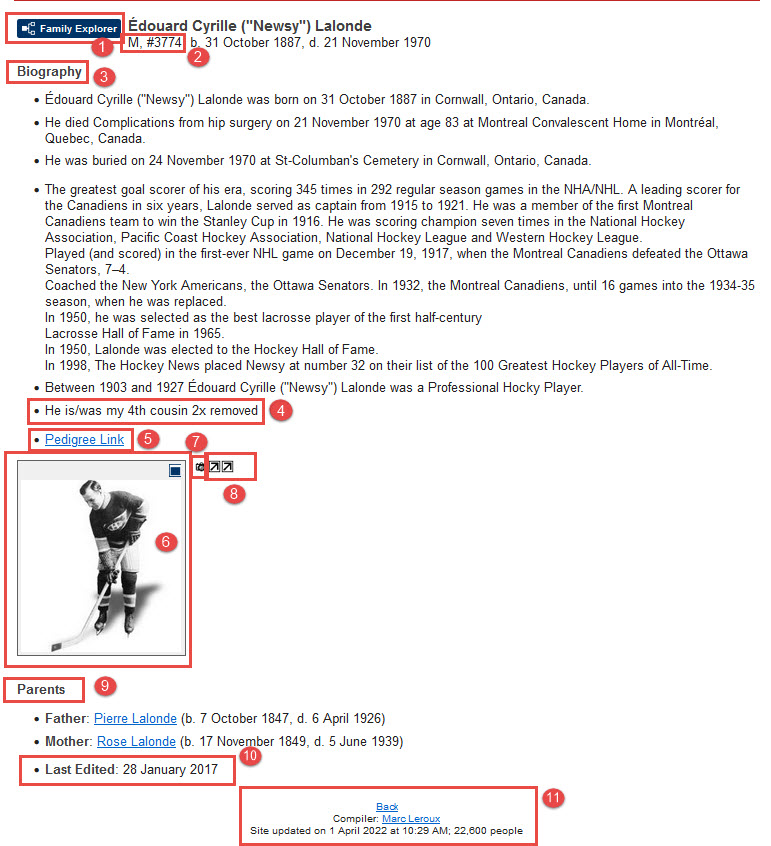Leroux-O'Connor Family site
Help

Leroux

O'Connor

Help Page
I have tried to make this site as easy to navigate as possible.The navigation is via the menus, and a short explanation is below
Menus
Home - the home page
Family - this drops down to some pages covering various aspects of my family
- People - how to find individuals in the database
- Search - a very versatile way to find individuals based on wildcards. A more detailed explanation, with examples, here.
- Interactive Pedigree Chart - An interactive way of looking at ancestors, in a more traditional family tree format. Note, at present it is only possible to ascend the tree, descending is not currently available. This form is also available on an individual entry basis.
- Surname Index - This will bring you to the list of surnames in the database.
Statistics - What can I say, I like numbers
- Database - This contains statistical data about the collected set of individuals in the database
- Longevity - How long people lived, based on the data in the database, at various periods of times, from the 1500's to the 1920's.
- Marriages - Age of marriages, based on the data in the database, at various periods of times, from the 1500's to the 1970's. These might surprise you
- Name Distribution - Frequency of surnames and first names for the data in the database.
More ... - Misc information, some about genealogy, some, well, just miscellaneous stuff.
About - Some information about this site, which you have obviously found if you ended up on this page
Search form
The search form is a very versatile way of finding individuals in the database. Each of the fields can be filled out individually and the results combined.

- The First and Surnames are the place to start.Enter the first name and last name in the appropriate fields and the search engine will return the entries that match that name. Note that it does not have to be the complete name. For example, if you enter "Grace" into the first name and "Walsh" int the surname, you will come up with Elizabeth Ann Grace Walsh.
- You can also use married names. Entering "Grace" into the first name and "O'Connor" into the spouse surname field will also return Elizabeth Ann Grace Walsh.
- It is also possible to enter an asterisk wildcard: Entering "mad*" into the first name field and "Allen" into the surname will come up with a list of names that contain "mad" as the first part of one of the names.
- Nicknames can also be entered. For example, if you enter "Newsy" as the first name, you will come up with the page for Édouard Cyrille ("Newsy") Lalonde.
- The use of dates make this a very powerful research tool. The date comprises the dat and a range (+/- 0, 1, 2, 5, 19 or 15 years). Entering 1730 with a range of +/- 5 years into the Birth Year field will find all the entries of people born between 1725 and 1785. Combining this with a surname, for example entering "Leroux", will filter the list to those with a name of Leroux born in that period.
- You can do some funky things like enter "Leroux" into the surname and spouse surname fields. This will retrieve the surprisingly large number of people in my family that married same-name cousins. The same principle can be used to see the list of Leroux-Lalonde interactions - again, likely cousins - Quebec was quite insular as it grew.
- Note: if you are looking for a name that has a diacritic punctuation, the search engine will not find the name if it is not present, or vice versa. For example, if you enter "Edouard", the engine will not fine entries with "Édouard". To circumvent this, I often add alternate names that do not have the diacritical punctuation. If you find some I missed, let me know and I'll correct them in future site updates.
Using the search form, you can easily structure queries that will find any individual or group of individuals in the database.
Individual page

- The "Family Explorer" button beside the name will bring up a graphical depiction of the person's ancestry (3 generations).
- The letter and number under the name indicate the gender of the person, M=Male in the example, and the # is the internal id for the person. Useful for me to find people, others, not so much.
- The "Biography" section lists all the information I know about the individual, in point form. This may include biographical information, information about their death or burial, where they lived, or just various tidbits of information.
- All of my relatives will have a tag to show how they are related. To decipher the meaning of this, try this page.
- Clicking on this link will bring up the interactive family tree explorer that will allow you to view the persons ancestry (3-5 generations).
- A photo (if I have one). Sometimes it may be a photo of the individual, sometimes it may be the image of a document.
- The camera icon indicates that there are other images available, clicking in it will bring up a page with that image.
- The diagional arrow indicates that there is a link to something on an external site, often wikipedia, but also other relevant sites.
- Parents. Clicking on these will bring up the page with information on the parents.
- When I last updated the information
- There are 3 parts to this. The "Back" link will navigate back to the last page the browser was on. Clicking on my name will bring up your default eMail form with my address defaulted in. The last line will show when the site was last updated, and the number of people in it.